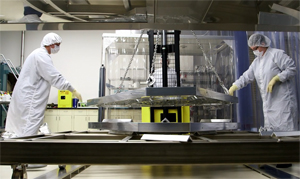Understanding LIGO
Published: 21 May 2014
The University's Institute for Gravitational Research is working within an international collaboration - LIGO - studying the detection of gravitational waves. The collaboration has recently released a new film explaining their work.
The University's Institute for Gravitational Research is working within an international collaboration - LIGO - studying the detection of gravitational waves. LIGO stands for Laser Interferometer Gravitational-Wave Observatory. The collaboration has recently released a new film explaining their work. The film includes a Glasgow researcher and shows some of the techniques that were developed in Glasgow being used at one of the LIGO observatories.
 The LIGO project is a global partnership led by Caltech and MIT that has built and run 4km long gravitational wave detectors at two sites in the USA. Along with other detectors in Germany, Italy and Japan, this forms a worldwide network.
The LIGO project is a global partnership led by Caltech and MIT that has built and run 4km long gravitational wave detectors at two sites in the USA. Along with other detectors in Germany, Italy and Japan, this forms a worldwide network.
The LIGO detectors are in the process of being upgraded to provide a much higher sensitivity and hopefully the first direct detection of gravitational waves from an astronomical event.
The Institute for Gravitational Research in the School of Physics and Astronomy, along with other UK partners, has been involved in the research and development of the technologies being used in the upgrades to the LIGO detectors, a project known as Advanced LIGO or aLIGO. Over the past few years, scientists and engineers from the group have worked on the design and subsequently the implementation of these technologies at the observatory sites.
As the installation of the new systems that form the upgraded aLIGO detectors nears completion, the video gives an insight into the work of the collaboration. It is of particular interest to Glasgow that the video shows the laser welding of the thin glass fibres used to suspend the 40 kg mirrors that form the test masses in the detector. The use of all glass construction and laser welding was originally pioneered at GlasgowUniversity and Dr Angus Bell can be seen in the video working at the LIGO Hanford site with the local installation teams preparing for just such an assembly.
To watch the video, go to: www.space.com/25489-ligo-a-passion-for-understanding-complete-film.html
First published: 21 May 2014
<< May

